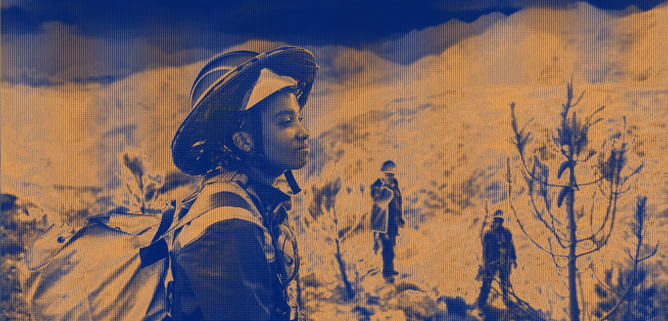Adapting the management of natural resources is an urgent matter and one that needs careful consideration. To many people who live in developed nations, water scarcity may not be of much concern. However, it is not an exaggeration to say that life revolves around water, and water scarcity grows in severity for each passing day in which no action is taken.
Restoring the planet’s natural resources is no easy feat - it takes time, money and international co-operation to make meaningful, long term progress.
Furthermore, there is a huge demand for natural solutions for water scarcity, that provide long term stability and protection to water sources. Both reforestation and deforestation-based measures, with the aim of restoring the natural and native environment, can each provide alternative solutions to protecting natural water resources.
Water scarcity is currently a plague to many countries in Latin America, particularly those that border the Pacific Coast. Peru unfortunately provides a prime example of how this is the case.
The cause of Peru’s water scarcity comes down to multiple factors, all of which negatively feed back into each other, catalysing the crisis. These include:
- Growing urban population
- Inefficient agricultural processes and practices
- Misuse of water resources
- Climate change
In addition 63% of Peru's population inhabit the Pacific Coastal region, where Peru’s land-use industries reside e.g. agriculture and mining. This is despite the fact that this territory only contains 1.8% of the country’s freshwater resources, putting a huge strain on Peru’s natural resources [1].
A National Water Plan was created to be implemented between 2015 to 2035 that addressed these environmental issues to provide an integrated solution [2]. The management of Peru’s natural water resources firstly relates to the environmental Sustainable Development Goals, namely SDGs 6 Clean Water and Sanitation, SDG 13 Climate Action, SDG 14 Life Below Water and SDG 15 Life on Land. This integrated approach also looked at positive resolutions that provided socio-economic benefits (SDG 2 Zero Hunger & SDG 3 Good Health and Wellbeing) as well as the strengthening of governance systems (SDG 16 Peace Justice and Strong Institutions).
A central part of the National Water Plan involved a reforestation scheme which recommended that 600,000 ha of land was to be reforested with native species of trees in order to protect natural water sources [2]. These new trees will provide protection to the top soil as well as controlling sediment flow, two vital components of protecting natural water sources.
The involvement of trees in protecting natural water resources is a widely adopted technique. Planting more trees can provide protection to the top soil as well as controlling sediment flow. Equally, in some circumstances, removing non-native trees and other flora from around water resources can also give rise to increased watersheds.
This particular example of a nature-based solution is one that The Nature Conservancy (TNC) adopted in South Africa when water supplies and watersheds dropped dangerously low after a three-year drought [3].
‘Day Zero’, 12th April 2018, was pre-determined as the day that Cape Town’s water supplies would run out. Strict water restrictions resulted in ‘Day Zero’ being postponed, however this was not a permanent solution - it was merely a mitigating measure to provide more time.
Removing non-native and invasive trees provided the answer in relieve Cape Town’s drastic water scarcity. Cape Town is located in the Cape Floristic Region, where over 70% of the plants are found nowhere else on earth. Non-native species such as Pine trees were introduced for timber and escaped from the plantations into the mountainous areas that makes up the watersheds upon which the region depends for its water. Science has shown that invasions of Pine and other non-native species such as Australian acacias and Eucalyptus are responsible for water losses of 55billion litres annually equal to two-months water supply for Cape Town.
The Greater Cape Town Water Fund, not only developed a long-term nature-based solution to restore the watersheds, but also adopted a sustainable funding strategy as a means maintain the restored areas over its 30-year lifespan. Although the primary purpose of the program includes removal of the non-native, invasive species to primarily protect the watersheds, the removal of these plants will additionally reduce the intensity and impact of wildfires and protect fertile top soil which benefits the native vegetation.
TNC is also working in Peru to utilise other natural solutions to its water crisis. To help local communities and agriculture, TNC is working in collaboration with the Lima Water Fund-Aquafondo in the recovery and establishment of 10 Amunas, that add up to 14.5 km. Amunas are an ancient canal system which pre-dates the Incas, to use as a filtration system. This system will draw the water from the mountains above Lima to below ground level, where the water can flow onto springs through natural aquifers, providing stable, long term natural intervention in lessening Peru’s water crisis.
Get Involved with The Nature Conservancy! Head on over to their website: https://www.nature.org/en-us/about-us/where-we-work/africa/south-africa/
References
[1] Salmoral, G., Zegarra, E., Vázquez-Rowe, I., González, F., del Castillo, L., Saravia, G., Graves, A., Rey, D. and Knox, J., 2020. Water-related challenges in nexus governance for sustainable development: Insights from the city of Arequipa, Peru. Science of The Total Environment, 747.
[2] Oecd-ilibrary.org. 2017. OECD iLibrary | Home. [online] Available at: https://www.oecd-ilibrary.org/...
[3] The Nature Conservancy. 2018. Nature-Based Solutions Could Protect Cape Town’s Water Supply. [online] Available at: https://www.nature.org/en-us/a...

